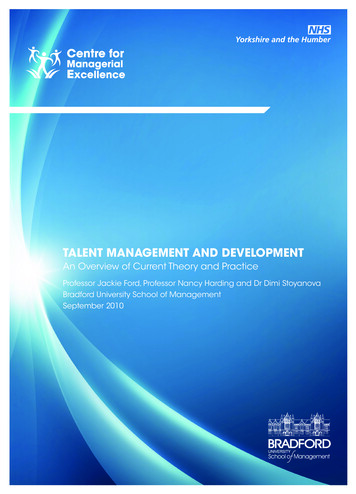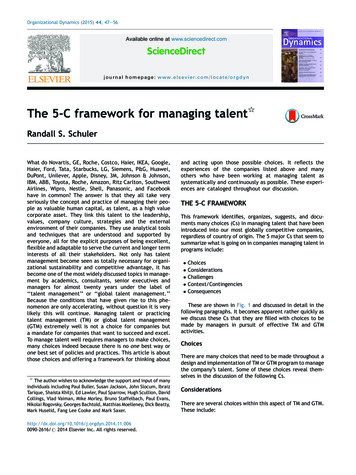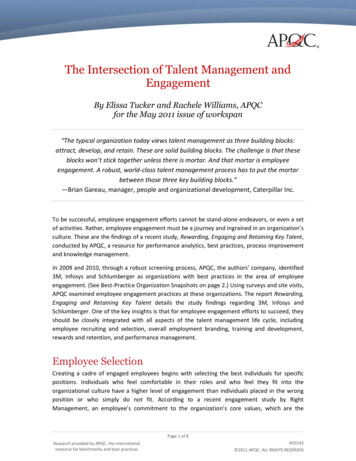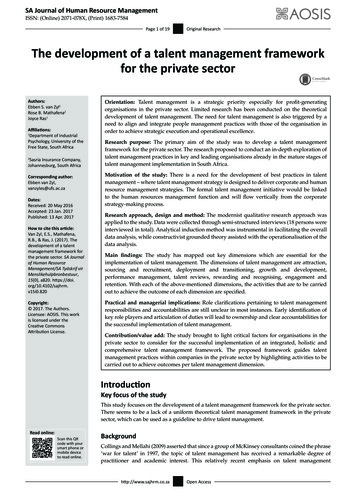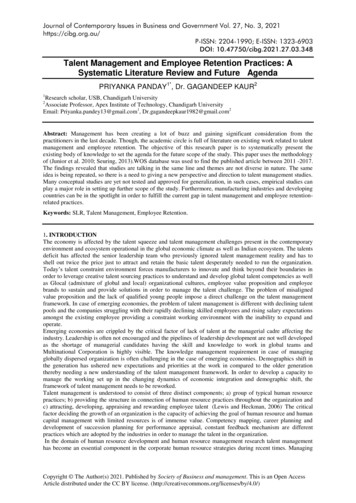
Transcription
Journal of Contemporary Issues in Business and Government Vol. 27, No. 3, 2021https://cibg.org.au/P-ISSN: 2204-1990; E-ISSN: 1323-6903DOI: 10.47750/cibg.2021.27.03.348Talent Management and Employee Retention Practices: ASystematic Literature Review and Future AgendaPRIYANKA PANDAY1*, Dr. GAGANDEEP KAUR21Research scholar, USB, Chandigarh UniversityAssociate Professor, Apex Institute of Technology, Chandigarh UniversityEmail: Priyanka.pandey13@gmail.com1, Dr.gagandeepkaur1982@gmail.com22Abstract: Management has been creating a lot of buzz and gaining significant consideration from thepractitioners in the last decade. Though, the academic circle is full of literature on existing work related to talentmanagement and employee retention. The objective of this research paper is to systematically present theexisting body of knowledge to set the agenda for the future scope of the study. This paper uses the methodologyof (Junior et al. 2010; Seuring, 2013).WOS database was used to find the published article between 2011 -2017.The findings revealed that studies are talking in the same line and themes are not diverse in nature. The sameidea is being repeated, so there is a need to giving a new perspective and direction to talent management studies.Many conceptual studies are yet not tested and approved for generalization, in such cases, empirical studies canplay a major role in setting up further scope of the study. Furthermore, manufacturing industries and developingcountries can be in the spotlight in order to fulfill the current gap in talent management and employee retentionrelated practices.Keywords: SLR, Talent Management, Employee Retention.1. INTRODUCTIONThe economy is affected by the talent squeeze and talent management challenges present in the contemporaryenvironment and ecosystem operational in the global economic climate as well as Indian ecosystem. The talentsdeficit has affected the senior leadership team who previously ignored talent management reality and has toshell out twice the price just to attract and retain the basic talent desperately needed to run the organization.Today’s talent constraint environment forces manufacturers to innovate and think beyond their boundaries inorder to leverage creative talent sourcing practices to understand and develop global talent competencies as wellas Glocal (admixture of global and local) organizational cultures, employee value proposition and employeebrands to sustain and provide solutions in order to manage the talent challenge. The problem of misalignedvalue proposition and the lack of qualified young people impose a direct challenge on the talent managementframework. In case of emerging economies, the problem of talent management is different with declining talentpools and the companies struggling with their rapidly declining skilled employees and rising salary expectationsamongst the existing employee providing a constraint working environment with the inability to expand andoperate.Emerging economies are crippled by the critical factor of lack of talent at the managerial cadre affecting theindustry. Leadership is often not encouraged and the pipelines of leadership development are not well developedas the shortage of managerial candidates having the skill and knowledge to work in global teams andMultinational Corporation is highly visible. The knowledge management requirement in case of managingglobally dispersed organization is often challenging in the case of emerging economies. Demographics shift inthe generation has ushered new expectations and priorities at the work in compared to the older generationthereby needing a new understanding of the talent management framework. In order to develop a capacity tomanage the working set up in the changing dynamics of economic integration and demographic shift, theframework of talent management needs to be reworked.Talent management is understood to consist of three distinct components; a) group of typical human resourcepractices; b) providing the structure in connection of human resource practices throughout the organization andc) attracting, developing, appraising and rewarding employee talent (Lewis and Heckman, 2006). The criticalfactor deciding the growth of an organization is the capacity of achieving the goal of human resource and humancapital management with limited resources is of immense value. Competency mapping, career planning anddevelopment of succession planning for performance appraisal, constant feedback mechanism are differentpractices which are adopted by the industries in order to manage the talent in the organization.In the domain of human resource development and human resource management research talent managementhas become an essential component in the corporate human resource strategies during recent times. ManagingCopyright The Author(s) 2021. Published by Society of Business and management. This is an Open AccessArticle distributed under the CC BY license. (http://creativecommons.org/licenses/by/4.0/)
Priyanka Panday et al/ Talent Management and Employee Retention Practices: A Systematic LiteratureReview and Future Agendatalent on pen and paper and leveraging them for the competitive advantage for the organization is two differentdimensions, Lawler and Bilson (2009).Talent management should not be taken as a single activity but rather it contains all the gamut of activitiesundertaken by the organization in order to retain their talented employees. Talent management is also defined asthe practice of managing the entire employee work cycle starting from the process of attracting and hiring to theto the ultimate of promoting and finding a successor upon retirement (Murthy, 2010), whereas, others viewtalent management as “finding the right person for the right job at the right time” (Jackson and Schuler, 1990).Some of the authors have identified talent management to be a practice of deliberately selecting and identifyingleadership material from its present employee in order to encourage individual advancement and fill up keypositions within the organization (Rothwell, 1994). Some of the authors have also identified talent to be criticalbecause of its role in providing strong human resources function in order to manage everyone for highperformance in the organization set up (Buckingham and Vosburgh, 2001). There is abundant literaturesupporting the relationship between talent management and retention within the organization. Better talentmanagement practices within the organization can lead to overall effectiveness within the organization andperformance of the employee. The research paper is organized as follows: first, we discuss the variousparameters of divisions of paper under review and we provide a theoretical framework for assessing thedifferent dimensions of talent management and retention practices. We screened each article with the goal ofextracting information relevant to our questions on the talent management and retention related components.Second the underlying methodology of this systematic literature review is outlined. We go on to present theresults of systematic literature review in relation to retention practices before discussing the findings andimplications of results critically. This study is unique in a way that it provides a systematic analysis of thestudies which enable researchers to identify the gaps easily. Overlapping of the studies while data coding is thebiggest limitation of this study as it makes the coding pattern of the systematic review little difficult to justify.2. Theoretical framework of paperIntending to identify the key components of studies in the Web of science database, we carried out a detailedanalysis of all papers published between 2011-2017, using review framework given by Lage Junior andGodinho Filho (2010), Jabbour (2013) and Seuring (2013). This method helps in identifying the core themes andcharacteristics of the studies. Following themes are used: Talent management in general; various components oftalent management; Talent management in manufacturing sector; Talent retention in general; Relationship oftalent management and retention. Taking into deliberation the main themes of the papers from the database, wepresent these themes in the following sub-sections. It is necessary to highlight that the main aim of the paper isnot to explore anything new related to the above said themes but to systematically present already publishedwork in Web of Sciences.2.1. Talent management in generalThis sections deal with the various dimensions of talent management definitions and understanding of talentmanagement by different authors in various part of the world.2.2. Various components of talent managementThis section deals with the components of talent management such as talent acquisition, recruitment andselection; training and development, career development; compensation and rewards; Succession planning andperformance management.2.3. Talent management in manufacturing sectorThis section specifically deals with the talent management practices employed in manufacturing sector. Talent,management is well explored and discussed topic in the service sector but these practices are not muchdiscussed in the context of manufacturing sector.2.4. Talent retention in generalRetention practices is linked with almost every dimension of human resource management. This sectionspecifically discuses the talent as a retention tool.2.5. Relationship of talent management and retentionThis section deals with the studies which have linked talent management as a tool for retention. Variousdimensions of talent management have been studied in order to establish the relationship between the two.Various studies have proven the strong positive relationship between talent management and retention practices.Journal of Contemporary Issues in Business and Government Vol 27, Issue 3, 20212896
Priyanka Panday et al/ Talent Management and Employee Retention Practices: A Systematic LiteratureReview and Future Agenda3. Method and research techniquesThis paper presents the systematic literature review of the papers published in web of sciences database from2011-2017. It gives a constructive analysis to gather round the results of studies on concurrent issues related totalent management and retention issues. This work is carried out using the following Steps: Analyzing available research papers in data base of web of sciences. Preparing a concise outline of the work done by the researchers in the area of talent management andretention. Analyzing the strength and weaknesses of studies. Providing future research outline and composition to find out unexplored areas to talent management andretention related studies.3.1. Work plan and execution of researchWe conducted analysis of the articles in the database of Web of sciences with the specific focus of talentmanagement and retention factor. We ran the analysis as per the sequence of the data file downloaded from Webof sciences presented in the table 1. Based on the quotation analysis, we evaluated the contribution and theimpact of the article published and we also analyzed the issues presented by the researchers to evaluate theirimpact and relationship between talent management and retention.Table 1: Classification and sub classification used in this paper1ContextA – Emerging/Developing countryB – Developed countryC – Not applicable2Geographic RegionA – USAB – ChinaC- IndiaD – Emerging EconomiesE – Scandinavian countriesF – AustraliaG- UKH– OthersI- Middle-East (gulf countries)J– Not-applicable3Objective of the studyA – Contribution towards the conceptual developmentB – Case StudyC – Review of LiteratureD – Not applicable4.Main Theme/subjectA –Linked to the talent managementB – Linked to the retentionC – Linked to the components of talent managementD – Not applicable5.Technique/ Method of studyA – QuantitativeB – QualitativeJournal of Contemporary Issues in Business and Government Vol 27, Issue 3, 20212897
Priyanka Panday et al/ Talent Management and Employee Retention Practices: A Systematic LiteratureReview and Future AgendaC – ConceptualD- Qualitative and QualitativeE – SurveyF – Case studyG- Empirical studyH – Not applicable6.Analysis periodA – 3 yearsB – 3-5 yearsC – 5-10 yearsD – More than 10 years7.E – Non-applicableSample sizeA-less than 50B-50-100C-100-150D- 150-200E-more than 200F-Non-applicable8.Sector wiseA – Private sectorB – Public sectorC – Public/Private (Both)D – Not applicable9.TopicsA – Correlation between Talent management and performanceB – Correlation between talent management and retentionC – Comparative analysis of policies that helps in talent managementD – Theoretical framework of talent managementE – Global trends in talent managementF – Talent management practicesG – Human Resource management Vs. Talent managementH – Correlation between Career development and talent managementI – Concepts and definitions related to areaJ – Techniques of Retention managementK- Compensation and reward management its relation with talent managementL- Correlation between development activities and talent managementM – Non-applicable10ResultsA – Present New Dimensions/PerspectiveB –In line with preceding work/studiesJournal of Contemporary Issues in Business and Government Vol 27, Issue 3, 20212898
Priyanka Panday et al/ Talent Management and Employee Retention Practices: A Systematic LiteratureReview and Future AgendaC – Previous model testing with different dataset/time periodD – Comparison studyE – Non-applicableIn this paper, we presented brief summary of the research papers analyzed for the present review study. Wecoded the articles in such a manner that all aspects can be covered and can present a holistic view of the workdone talent management and retention.The main classification is done on the basis of 10 big parameter, labeled from 1 to 10, coded using letters fromA to M , as shown in Table 2.beside this, due to wide scope of studies, an article could receive multiple codes.The first classification involves context of the research papers. We use codes A to C. context is very crucial as itenables us to understand the larger picture of the study about talent management and retention. Also, one of ouraims is to confirm whether in developing countries the concern for talent management practices are morefrequently use than in developed ones. Therefore we created two different heads named developing anddeveloped countries. The code non-coded is also included for the studies which doesn’t fall under above twocategories. The other category has division on the basis of geographic region, coded A to J including nonapplicable code. This classification helps in analyzing the specific regions which are ahead in talentmanagement and related studies.Third classification includes the various objectives of the studies, coded by letters A to D. for example, in thisclassification, we have assessed whether it conceptually contributes to the subjects; Presents a case study or aliterature review, including the non-applicable option. It enables us to identify analysis in a more useful manner.The fourth classification deals with the main topics of the articles in regards to talent management and retention,coded by the letters A to C. It helps us to identify the key issues on the talent management in the analyzedresearch papers.The fifth category deals with the method used in research papers, which coded by letters A to G. hence, weidentify the commonly used method by the most authors in articles.The Sixth classification involves the analysis period of the research papers, coded by letters A to E. it isimportant to highlight that it includes all the articles published and available with web of sciences from 2011 to2017The seventh category involves the sample size on the basis of analyzed research papers, coded by letters A to D.We intend to see the extent of sample being taken by the researchers to conduct study.The eighth classification involves identifying the analyzed sector, coded by letters A to D. The focus is to findout the sector mostly used for the study the main focus point was to identify, whether the discussion of talentmanagement and retention is better addressed n private sector or public sector, since private sector is perceivedto be more active in talent management and retention related issues.The Ninth classification highlights the various aspects of the articles, coded with letters from A to E. It assessedwhether the papers gives some dimensions to the study or give the extension to the exiting study.Lastly, the tenth classification revealed the breadth of the results of the articles, classified with letters from A toE. Thus, we sought to assess the results found in the analyzed articles. This category is to analyze whether theresearch papers under study adds new streams to the literature or bot.4. RESULTS AND DISCUSSIONIn this part, all categories of research papers and codes are presented as shown in table 2; afterwards graphicalrepresentation of the same is done.Table: 2 data classification and categories of csResults1CICA; A;GA;B5ADAABEFAC;DAJournal of Contemporary Issues in Business and Government Vol 27, Issue 3, 20212899
Priyanka Panday et al/ Talent Management and Employee Retention Practices: A Systematic LiteratureReview and Future A;BJournal of Contemporary Issues in Business and Government Vol 27, Issue 3, 20212900
Priyanka Panday et al/ Talent Management and Employee Retention Practices: A Systematic LiteratureReview and Future AEAA;CGAEAAC75ADAAGACAD;FBJournal of Contemporary Issues in Business and Government Vol 27, Issue 3, 20212901
Priyanka Panday et al/ Talent Management and Employee Retention Practices: A Systematic LiteratureReview and Future AB;CAFDMA4.1 ContextThe first classification is to explore contacts of the research papers. The context was coded as following: ADeveloped countries; B-Emerging countries; C-not applicable.The results acquired after analyzing 108 articles shown in figure 1, results clearly indicates that most of thestudies are focused on developing countries, However very few research papers analyzed developed countries.Journal of Contemporary Issues in Business and Government Vol 27, Issue 3, 20212902
Priyanka Panday et al/ Talent Management and Employee Retention Practices: A Systematic LiteratureReview and Future AgendaThis indicated that talent management issue has been addressed in emerging countries more. This subject is anissue of global concern so the result of the literature review indicates a gap that needs to be further addressed.Fig.1: Context of Analysis4.2 Geographic regionThe second classification is to identify the specific region, coded in the article in the following manner: A –USA; B – China; C- India; D – Emerging markets’ – Scandinavian countries; F – Australia; G- UK; H– Othercountries; I- Middle-East (gulf countries); J– Non-applicable.the classification of the countries is not based onspecific geographic location or continents, it is based on location clusters made from researched articles. Theanalysis may be better understood from figure 2.thus, we noticed that most of the studies have taken more thanone countries into consideration, specifically the studies which has been conducted in developed countries. Thisdemonstrates that talent management studies are relatively widely spread.Fig.2: Geographic Region4.3 ObjectiveThe third classification is based on the objectives of the study. They were coded in the following manner: Aconceptually contributes to the subjects; B-case study; C-review of related literature; and D- Non-Applicable.Thus figure 3 represents the results obtained for the category from the researched articles. Most articles arecontributing towards the conceptual aspect of the talent management; only 15% articles are based on literaturereview. Case study is also not very common for this particular are of study. In relation to these results, we haveidentified gap 1: constructing the conceptual boundaries for the talent management as even after so manystudies, there is a lot of ambiguity about the concept.Journal of Contemporary Issues in Business and Government Vol 27, Issue 3, 20212903
Priyanka Panday et al/ Talent Management and Employee Retention Practices: A Systematic LiteratureReview and Future AgendaFig.3: Objective of the study4.4 Main Subject of the StudyThe fourth classification is related to main subject of the articles studied, coded by the letters A to D, in which A– It is related to the talent management; B – It is related to the retention; C – It is related to the components oftalent management; D – Non-applicable, as shown in the figure 4.The analysis indicates that extensive researchis required to establish the link between several broad areas of talent management and retention. Furtherinnovation is required in the conceptual aspect of talent management. 63% articles are related to various aspectsof talent management, less than 10% studies are related to the linkage between talent management and retention.The other articles had variable concerns and 5% deals with other components of talent management. Based onthese data, 23 can say that there is a sensitization amongst the part of researchers regarding the linkage of talentmanagement and retention and this research area is still nascent so has many opportunities for the further work.Fig.4: Theme of the study4.5 MethodThis classification explores the method used in researched articles, coded from a-h as a code, in which: A –Quantitative; B – Qualitative; C – Conceptual ; D- Qualitative and Qualitatively – Survey; F – Case study ; GEmpirical study; H – Non-applicable.the results are presented in figure 5.majority of the study have appliedmore than one techniques for the one study. Qualitative studies are more found in this analysis as compared tothe quantitative ones; highest numbers of studies are empirical in natureJournal of Contemporary Issues in Business and Government Vol 27, Issue 3, 20212904
Priyanka Panday et al/ Talent Management and Employee Retention Practices: A Systematic LiteratureReview and Future AgendaFig.5: Method used in the studyNote: B;H/ E;G/D;E;G/C;G/A;C;G combination of methods are also found once each in the review.4.6 Analysis PeriodThis classification represents the analysis period of the researched studies. Studies are coded from A-Eaccording to the following ways: A – Less than 3 years; B – Between 3 and 5 years; C – Between 5 and 10years; D – More than 10 years; E – Non-applicable. Analysis indicated that nearly 72% of the studies have beenconducted taking less than 3 years time period into consideration.Lastly, the ninth category analyses the period in which the analysis were developed in the articles, coded byletters A–E , in which: A – Less than 3 years; B – Between 3 and 5 years; C – Between 5 and 10 years; D –More than 10 years; and E – Non applicable. The results are presented in Figure 6. A large number of articleshad their analysis based on a 3–5 years period, 19% of the articles, and 5–10 years, 18% of the articles. Therewas a smaller quantity in the less than 3 years and more than 10 years categories, 4% and 12% of the articles,respectively.Fig.6: Analysis period4.7 Sample SizeThe seventh classification represents the sample size coded from A to E. results depicts that big sample studieshave been extensively conducted.Journal of Contemporary Issues in Business and Government Vol 27, Issue 3, 20212905
Priyanka Panday et al/ Talent Management and Employee Retention Practices: A Systematic LiteratureReview and Future AgendaFig.7: Sample Size4.8 Sector AnalyzedThe eighth classification involves identifying the analyzed sector in the studies, coded by letters A–D, in thefollowing terms: A – Private; B – Public; C – Private/Public or Public/Private, and D – Non-applicable. Thus,we present the results of this category in Figure 8. The great majority of articles address the private sector, witha smaller quantity focusing only on the public sector. The latter is mostly analyzed when compared to theprivate sector, as shown in Figure 8. There is also the ‘Non-applicable’ class, which includes other articles thatdo not focus on an analysis of a specific sector and articles that have a mainly conceptual approach.Fig.8: Sector wise Analysis4.9 Approached topicThe Ninth classification relates to the subjects approached by the articles, coded in the following way: A –Correlation between Talent management and performance; B – Correlation between talent management andretention; C – Comparative analysis of policies that helps in talent management; D – Theoretical framework oftalent management; E – Global trends in talent management; F – Talent management practices; G – HumanResource management Vs. Talent management; H – Correlation between Career development and talentmanagement; I – Definition of the concepts of the area; and J – Techniques of Retention management; KCompensation and reward management its relation with talent management; L-Correlation betweendevelopment activities and talent management; M – Not related to above 10 Results. The topics most appearedin the papers are mostly related to talent management policies and framework.Journal of Contemporary Issues in Business and Government Vol 27, Issue 3, 20212906
Priyanka Panday et al/ Talent Management and Employee Retention Practices: A Systematic LiteratureReview and Future AgendaFig.9: Approached topics of the studyNote: B;F;J/ A;B;C;F;H;K;L/ B;J/ C;F;H;K;L/ C;F;G/ C;D;F/ C;L/C;F;I/ D;E/D;E;F/ D;E;F;G;I/ E;M/ E;F;L/F;L/ D;I/ A;G/ A;C;F/ A;C;D;F;I;L/ A;B;C;F;H;K;L/ A;C;D;F/ A;C;F;H/ A;B;F;L these above writtencombination of topics have also appeared once in the research papers4.10 Results of the articleThe last classification presents the results of the articles and was classified with letters A–E.A – New perspectives; B – Consistent compared to other articles; C – Previous model with different dataset/timeperiod; D – Comparison; and E – Non-applicable. The results obtained are seen in Figure 10. It shows thatresearch is growing positively towards creating a new perspective and adding new dimensions to the study.More empirical studies are required to test the conceptual work and new concepts.ResultsB;CA;BE ( Not applicable)C ( Previous model with different B (Consistent with previous literature)A ( New perspectives)0Results102030405060Fig.10: Analysis of ResultsNote: A; B; D/A; C; D combination of results are also found once each in the review.5. CONCLUSIONS AND RECOMMENDATIONSThe research developed in this research paper had its central theme around relationship between talentmanagement and retention practices. There are any opportunities for to researchers to work on gaps further. Thearticle from Web of sciences database indicates that the concern related to talent management is growing asretention is becoming very difficult. It becomes mandatory for the companies to adopt practices which suits toyoung generations. Our method of study primarily followed the method given by Lage junior and Godinho Filho(2010) [1] but little variation was made by us as we selected a complete database instead of one journal.Theanalysis was done under 9 different categories, which highlighted 8 gaps in the literature. We noticed that thereare still some untouched aspects of talent management which needs to be addressed. Further the relationshipbetween talent management and retention also requires to be studied using more quantitative methods. Thisstudy helped us to introduce and present an overall perspective of the articles available in Web of sciencesJournal of Contemporary Issues in Business and Government Vol 27, Issue 3, 20212907
Priyanka Panday et al/ Talent Management and Employee Retention Practices: A Systematic LiteratureReview and Future Agenda6. REFERENCES1. Junior, M. L., & Godinho Filho, M. (2010). Variations of the kanban system: Literature review andclassification. International Journal of Production Economics, 125(1), 13-21.2. Jabbour, C. J. C. (2013). Environmenta
thereby needing a new understanding of the talent management framework. In order to develop a capacity to manage the working set up in the changing dynamics of economic integration and demographic shift, the framework of talent management needs to be reworked. Talent management is understood to consist of three distinct components; a) group of .

